| Reviews & Columns |
|
Reviews DVD TV on DVD Blu-ray 4K UHD International DVDs In Theaters Reviews by Studio Video Games Features Collector Series DVDs Easter Egg Database Interviews DVD Talk Radio Feature Articles Columns Anime Talk DVD Savant Horror DVDs The M.O.D. Squad Art House HD Talk Silent DVD
|
DVD Talk Forum |
|
|
| Resources |
|
DVD Price Search Customer Service #'s RCE Info Links |
|
Columns
|
|
|
Sling Blade: 2-Disc Collector's Edition
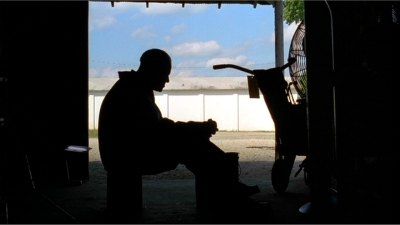
It's hard to believe that almost 10 years have passed since Billy Bob Thornton's modern classic, Sling Blade (1996), first wandered into theaters. As writer, director and star of the film, Thornton became as close to an "overnight sensation" as it gets, quickly earning the sincere respect of his peers in all three categories. Shortly after its release, Sling Blade would earn him a well-deserved Academy Award for Best Adapted Screenplay (he was also nominated for Best Actor, but lost to Geoffrey Rush for his performance in Shine). Though he's always been something of an outsider to the Hollywood machine, he's still managed to fit in quite nicely. Whether dining with other celebrities or munching on barbecue and tater tots, Thornton maintained his blue-collar reputation and has continued to make films about the things he's most familiar with.
Sling Blade remains his pride and joy, a film made completely on his own terms. Thornton originally conceived the character of Karl Childers nearly a decade earlier---often including him as part of a one-man show---but he wouldn't be seen on film until 1994's Some Folks Call it a Sling Blade, a short film directed by George Hickenlooper (The Man From Elysian Fields). Childers' gruff voice, slumped stature and grunt-laced dialogue presented audiences with a simple man whose harsh upbringing led to a broken life. His parents treated him like an animal: he was forced to live in a small shed behind the house, often only visited by his mother for Bible lessons. After young Karl was convicted of two brutal murders before reaching his teenage years, the young man was locked away in the state hospital.
After 25 years, he was released as an adult who never really lived a normal life.
I'll spare the standard plot rundown from here on out; after all, Sling Blade isn't a film whose greatest strengths are found in linear storytelling. Where this film really shines is its authentic atmosphere and terrific characters---from Thornton's captivating lead performance all the way to the film's understated production design, this film was a real labor of love (and with a budget of under $1M, it pretty much had to be). While Sling Blade moves along at a much more deliberate pace than---well, even your typical drama---it never drags its feet along the way.
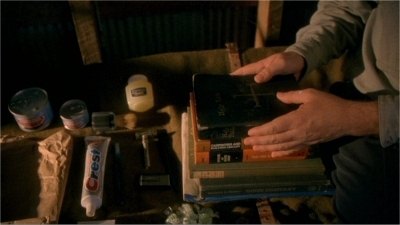
In fact, it's hard to watch a film like Sling Blade without noticing how focused it really is. While it's really Thornton's baby, he's surrounded by a cast and crew that shows how some projects are much more than the sum of their parts. Supporting performances are equally balanced by acting veterans and new faces; for example, pros like Robert Duvall (as Childers' estranged father), John Ritter (as Vaughan, a semi-closeted gay neighbor) and J.T. Walsh (as Charles, a repulsive man also in the state hospital) shine in their respective roles. We also see breakthrough performances by Natalie Canerday (as Linda, who takes Karl in after his release), musician Dwight Yoakam (as Doyle, Linda's abusive boyfriend) and Lucas Black (as Frank, Linda's son and best friend to Karl). Even complete newcomers like Rick Dial (as Bill Cox, Karl's boss) turn in great performances, despite having little to no previous acting experience. Composer Daniel Lanois' score is a perfect match to the film's most dramatic moments---and even the more subtle ones---rounding out the atmosphere quite nicely.
The finished product was a hit with critics and audiences alike: it earned roughly $25M at the box office, defying expectations for a film made on a shoestring budget. The Criterion Collection treated the film with an appropriate amount of respect shortly thereafter, presenting laserdisc buffs with an excellent Special Edition of the film. Miramax's first DVD effort---alll the way back in 1998---was a barebones disc, presenting the film with a non-anamorphic transfer and no bonus material. Though the film's 10th Anniversary isn't until next year, Miramax has decided to get the party started early with a well-deserved 2-Disc Collector's Edition. In all regards, it's worth the wait.
In addition to a brand new anamorphic transfer and a nice chunk of extras, we're also given a new Director's Cut of the film by Billy Bob Thornton. If you're worried that needless side-stories and extra padding have been slapped on to sell a few DVDs...well, don't be. What we get is a slightly modified cut that adds roughly 15 minutes of new and extended scenes back into the film, rounding the total running time up to a generous 148 minutes. In short, there's some great character development that only adds more detail to an already great film. Still, there's plenty of readers who want all the details, so below you'll find a complete list of all the new scenes added to the Director's Cut. To my knowledge, all of these deleted scenes could originally be found on Criterion's laserdisc, but they've been newly remastered to blend in seamlessly with the theatrical release.
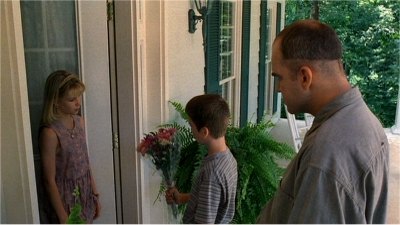
So...what's new to the Director's Cut?
Here's what it is and when it happens, give or take a few seconds...
(Mild spoilers below)
(17:30) - The opening scene where Karl arrives in town is extended by about 30 seconds.
(29:30) - The scene where Karl spends the night at Dr. Woolridge's house is extended slightly.
(31:30) - A shot of Dr. Woolridge and Karl arriving at Bill Cox's shop has been added.
(1:04:00) - A new scene involving Doyle, Frank, Karl and Linda has been added, shortly before Doyle's terrible garage band comes over for practice.
(1:07:00) - A new scene with Doyle, Frank, Karl and the band going out for more beer (and meeting the "cops") has been added.
(1:17:00) - A new scene with Frank and Linda has been added, shortly after Doyle's outburst.
(1:37:00) - A new scene with Frank and Karl delivering flowers to his young "girlfriend's" house (seen above) has been added.
(1:45:00) - A new scene with Frank and Karl talking in the garage, shortly before they play football, has been added.
(2:00:00) - A very brief scene showing Karl gathering his things, just after he's kicked out of the house by Doyle, has been added.
(2:13:00) - The scene where Karl finally confronts Doyle at his house has been extended, showing a bit of hesitation on Karl's part.
(End spoilers)
So...did it make Sling Blade better?
For the most part, yes. Smaller moments of character interaction---especially those between Karl and Frank---only deepened their relationships further, though the "flower delivery" scene didn't add much other than a stronger indication of Karl as a father figure. The last addition was certainly a strong one, really mounting the tension nicely before the film's emotional climax. Only a few of the minor scene extensions didn't alter the impact of the film for the better, though they're small enough not to be considered hindrances. Still, I'd imagine most viewers will want to judge for themselves; while it's unfortunate that the original cut couldn't have been included as well, I can safely say that fans of the Sling Blade's overall tone shouldn't mind a few extra minutes here and there.
In any case, we've still got plenty of ground to cover. Let's get started, shall we?
Widescreen TV owners (and those with 16:9 squeeze options on their 4:3 sets) will spot a few notable improvements, as this new Collector's Edition of Sling Blade features a brand new 1.85:1 anamorphic widescreen transfer that defies the film's modest budget. Colors and overall image detail are smoother and more natural, with several problems that plagued the original release (edge enhancement, halos) no longer surfacing. There's also a minor shift in several of the overall compositions: the Collector's Edition transfer appears to expand the side information a bit, though information on the top and bottom seems to have been raised or lowered on a few occasions (especially visible in Image #2, above). The majority of the compositions appear slightly more "balanced" with this new framing, though it's not enough of a change to really add or detract from the viewing experience (especially with overscan taken into account). Regardless of any mild framing changes, the improved clarity and color balance really make a big difference. Thornton set out to capture a down-to-earth atmosphere with Sling Blade, but there's plenty of beautiful sights to be seen along the way.
It's not a huge difference, but the serviceable 2.0 Surround mix found on the original release has been replaced with a new 5.1 Surround mix. There's not a terrible amount of ambience during the bulk of the picture, but those with the appropriate setups should notice a slightly more enveloping atmosphere. Composer Daniel Lanois' score is only one highlight, as it really opens up nicely during some of the film's more dramatic moments. Still, the original 2.0 mix should have been included for those without 5.1 setups, so the audio rating has been docked half a point to reflect this (the original score would've been 4.5). Also missing is the French 2.0 track, though it wasn't a necessary inclusion in the first place. The main feature has been presented with optional English captions and Spanish subtitles; though the original white subs have been replaced with less favorable yellow ones (and placed a bit high, if you ask me), they're a more accurate match to the film's dialogue.
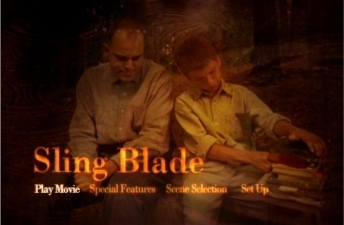
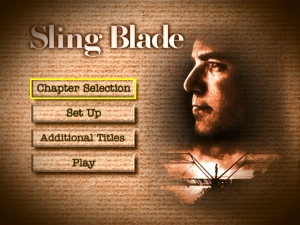
Seen above, the Collector's Edition (above left) offers a much more appropriate design and atmosphere compared to the 1998 release (above right). The easily-navigated menus are a breeze to go through, and the addition of Lanois' score is a terrific complement to the animated images. The 148-minute film has been divided into 30 chapters---as opposed to the original cut's 25---and a layer change was detected near the 75-minute mark. The packaging is a slight improvement over the original 1998 disc, though it's still a bit text-heavy on the front. This 2-disc release is housed in a slim double keepcase, coupled with a nicely-designed insert booklet that includes photos, trivia, a complete content list, and a reprint of a 1997 Esquire article written by Mark Jacobson.
Ahh, 1998: when DVDs could easily get away with non-anamorphic transfers and no bonus features. Seven years later, studios have learned from the mistakes of the past---well, in most cases---and fans will notice the difference after wading through the heap of extras spread over this 2-disc set! Aside from the Director's Cut of the film, Disc One also contains a somewhat-new Audio Commentary featuring main man Billy Bob Thornton. The lion's share of this track has apparently been ported over from Criterion's laserdisc, while the newly-integrated scenes feature more recent remarks from Thornton (with a few new words during the opening scenes and closing credits). The tone of the commentary is relaxed but very informative; despite frequent gaps in the conversation, those who like the deliberate pace of Sling Blade should enjoy this track. The integration of newer remarks is fairly seamless, though there's occasionally a bit of overlapping information (and a few slight volume shifts, too). Still, it's nice to know this excellent vintage commentary hasn't been left out in the cold.
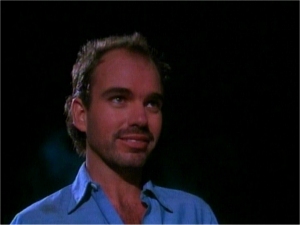
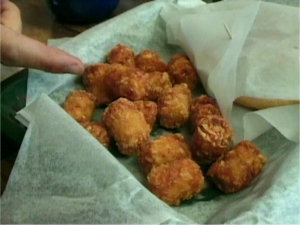
Moving on to Disc Two, we're presented with a slew of behind-the scenes goodness and retrospective documentaries---it's literally as if Billy Bob stumbled onto the set of This Is Your Life. Kicking things off is another extra originally found on Criterion's laserdisc: the award-winning documentary Mr. Thornton Goes to Hollywood (1996). This 67-minute documentary offers plenty of insight in Thornton's formative years, including childhood memories and clips from his earlier film and TV roles (above left: Chopper Chicks in Zombietown, 1988). There's more than just a few fond memories and laughs, though: we also see a man who really sacrificed a lot to make a name for himself in the movie business. Next up, there's an interesting Bravo Profile on Thornton (44 minutes), presented in a similar style to the aforementioned documentary. There's a bit of overlapping information and a few re-told stories, but this piece focuses more on recent experiences: in short, it's mostly life after Sling Blade. Perhaps the most interesting segment features Billy Bob and some of the crew on a road trip throughout his native Arkansas, where we get acquainted with a few of the locals and Thornton shows us city folk what real tater tots ought to look like (mmm...above right).
We're also treated to a lengthy Roundtable Discussion with Thornton, Dwight Yoakam, Mickey Jones and producer David Bushnell (below left, 76 minutes). It runs a bit long---especially given the straightforward presentation style---but it's still a meaty collection of fond remembrances. The three actors do the majority of the talking, although Dwight Yoakam (seated on the far left) tends to hide behind his hat on occasion. If you're looking for a technical dissection of the film, you'll probably walk away disappointed; if you're just looking for a mess of interesting stories, you'll have a good time.
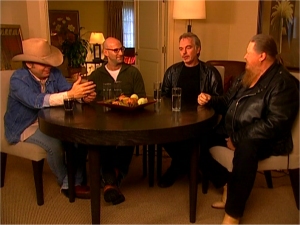
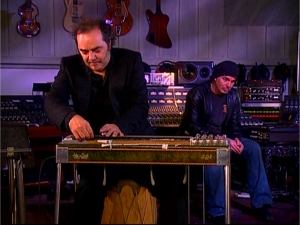
Next up are a series of Conversations with members of the cast and crew, starting off with a pair from Thornton and Robert Duvall (the second is a solo Duvall interview). At just under 10 minutes apiece, it's a nice chance to see these longtime friends share some time together---though Duvall only spent a day on the set of Sling Blade, it's no secret that his presence really impacted the film. A conversation with Thornton and composer Daniel Lanois is next (above right, 23 minutes), bookended by a terrific live performance of a piece from the film's soundtrack and the accompanying scene in the film. Moving on, there's also a curious bit of on-the-set goofing with Billy Bob in character, called The Return of Karl (4 minutes)---though there's no real backstory given on the situation, it's a nice break from all the interviews. There's also some additional On the Set Footage, including pieces of behind-the-scenes footage featuring Thornton directing and Doyle's awful garage band practice (9 minutes total). Winding things down, we also get a curious bit of band-related footage called Doyle's Dead along with an introduction by Thornton (4 minutes total). Apparently, this footage would have played after the film's final credits, but was eventually trimmed off by the director. Last but not least, there's a few text Reviews by writers Richard Corliss, Stanley Kauffmann and Anne Beatts.
Overall, a very satisfying assortment of new and old bonus features---in fact, with the audio commentary and newly-added scenes from the first disc, there's nearly seven hours of goodies to dig through! Only two notable extras are nowhere to be found: the original short film Some Folks Call it a Sling Blade (available on DVD as a stand-alone release, possibly not included for rights issues) and the film's theatrical trailer (which wasn't on the first DVD either, but can apparently be found on Criterion's laserdisc). There were mentions of additional cut material during the commentary and other interviews, but the descriptions were good enough for me. In any case, ardent fans of Sling Blade will be thrilled with the exhaustive set of bonus features found on this 2-Disc set.
Owners of the original 1998 release knew there was nowhere to go but up, so it's great to know that this new 2-Disc Collector's Edition really swings for the fences. The improved technical presentation should be more than enough reason for fans to upgrade, but the hours of vintage and retrospective bonus features on Disc 2 are the real icing on the cake. Aside from the unfortunate exclusion of the original short film, there's more than enough solid material to satisfy even the most reluctant DVD double-dipper. Miramax has really covered the bases well the second time around, and the surprisingly low retail price on this jam-packed 2-Disc set makes it a must have for fans of this modern classic. Some folks call it Highly Recommended...I call it part of the DVD Talk Collector Series.
Randy Miller III is an art instructor hailing from Harrisburg, PA. To fund his DVD viewing habits, he also works on freelance graphic design and illustration projects. In his free time, Randy enjoys slacking off, general debauchery and writing things in third person, mm-hmm.
|
| Popular Reviews |
| Sponsored Links |
|
|
| Sponsored Links |
|
|
| Release List | Reviews | Shop | Newsletter | Forum | DVD Giveaways | Blu-Ray | Advertise |
|
Copyright 2024 DVDTalk.com All Rights Reserved. Legal Info, Privacy Policy, Terms of Use,
Manage Preferences,
Your Privacy Choices | |||||||













